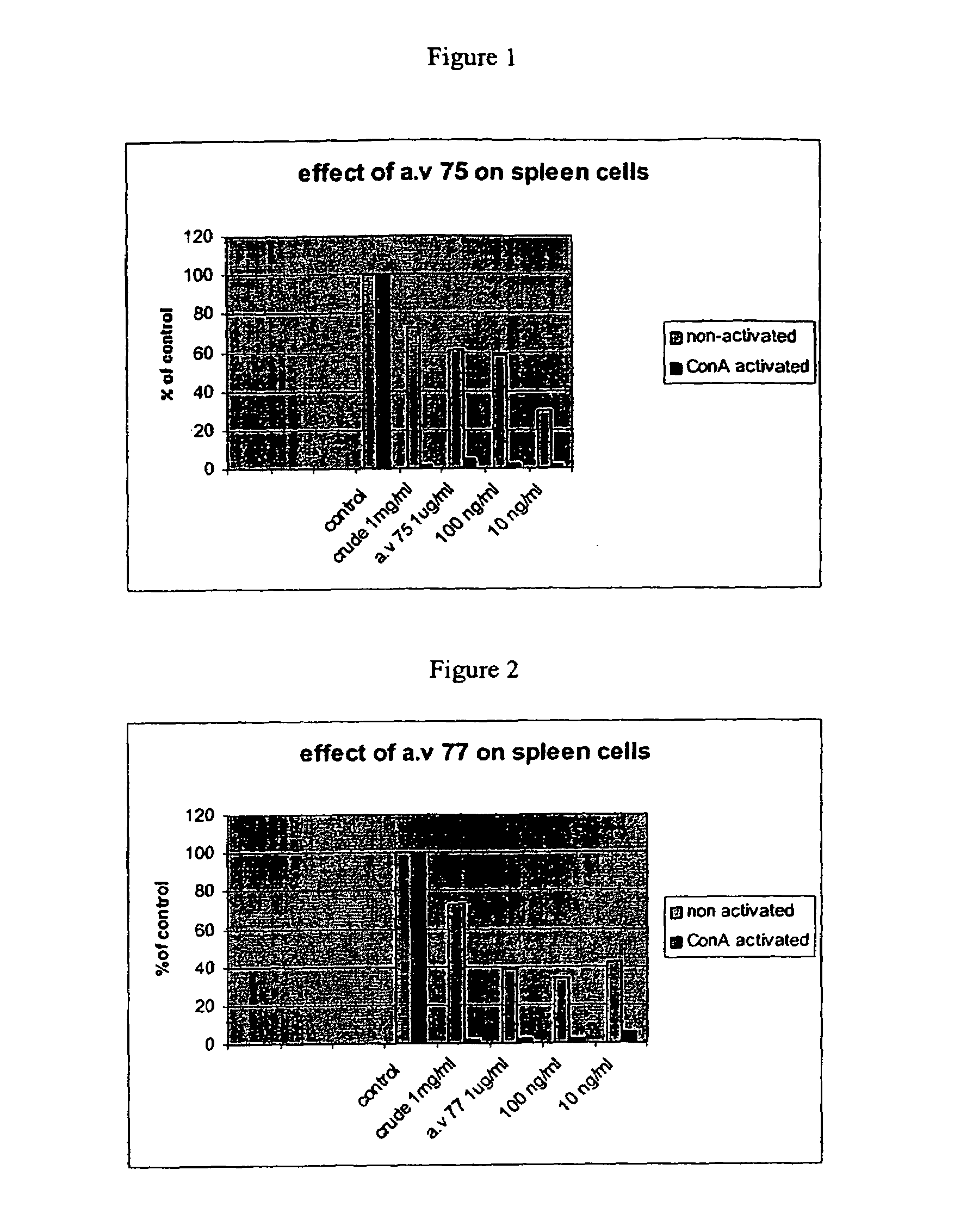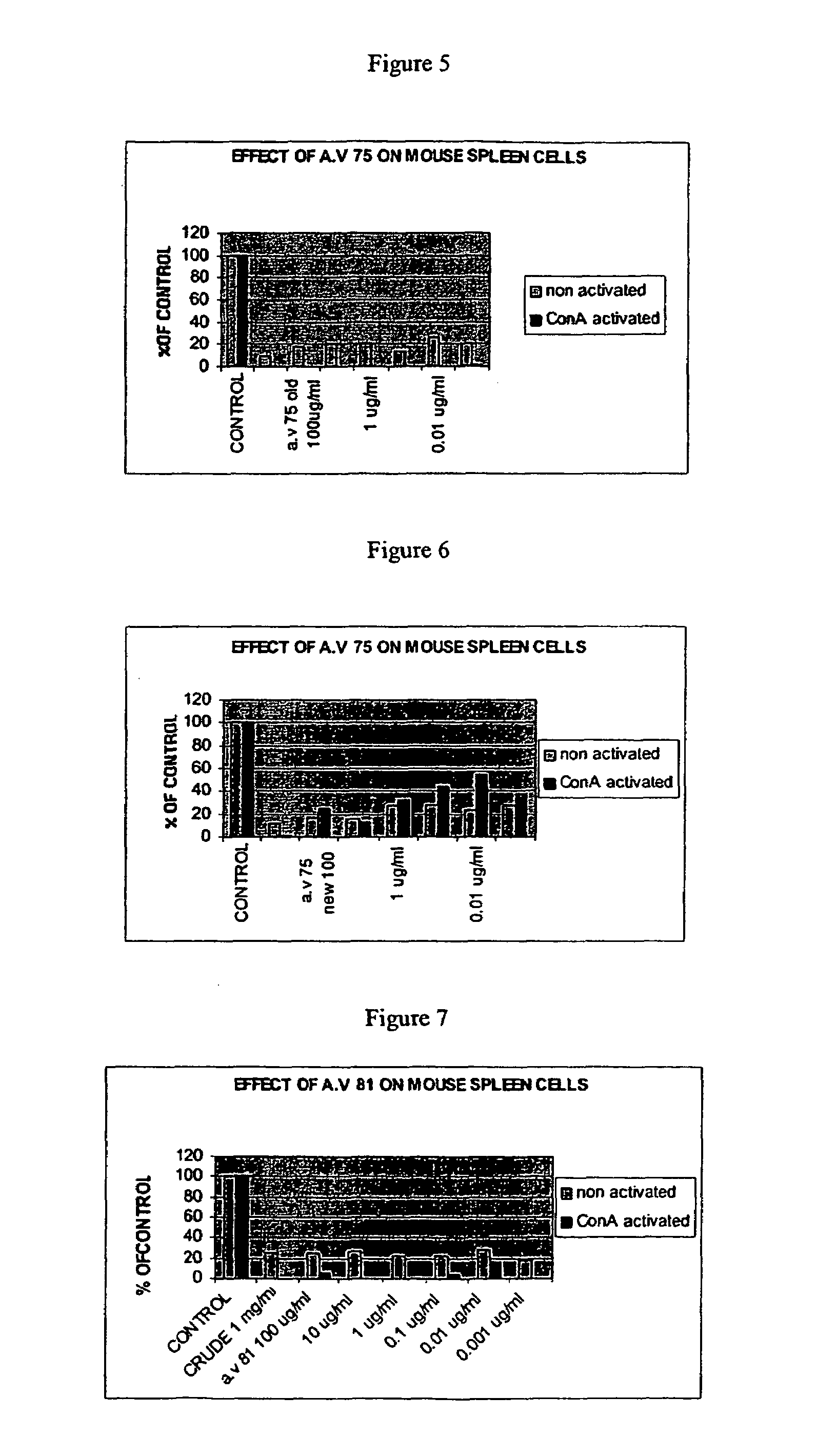Compounds for use in the treatment of autoimmune diseases, immuno-allergical diseases and organ or tissue transplantation rejection
a technology for immunoallergical diseases and compounds, which is applied in the field of compounds for use in the treatment of autoimmune diseases, immunoallergical diseases and organ or tissue transplantation rejection, can solve the problems of psoriasis sufferers suffering discomfort, immune system diseases pose a major threat, and subsequent exposure to harmful immunologic reactions
- Summary
- Abstract
- Description
- Claims
- Application Information
AI Technical Summary
Benefits of technology
Problems solved by technology
Method used
Image
Examples
example 1
Synthesis of Compounds
[0218]Compounds of the invention were synthesized and characterized as described below.
[0219]
[0220]0.66 gr, 4 mM, 4-hydroxy hydrocinnamic acid and 4 ml thionyl chloride in 30 ml cyclohexane were refluxed for 2 hours. Evaporation gave a yellow solid to which were added 0.9 gr, 4 mM, phenyl alanine ethyl ester HCl, 30 ml dichloromethane and 1 ml triethyl amine. After stirring 2 hours at room temperature, water and KOH were added to neutral pH and the reaction extracted with dichloromethane Evaporation gave a light yellow viscous oil, which was triturated and recrystallyzed with ethanol to give 0.25 gr, 18%, white solid, mp-213.
[0221]NMR CDCl3 7.30-6.9 (9H, m), 4.20 (2H, q, J=7.0 Hz), 3.30 (1H, m) 3.10 (2H, t, J=7.2 Hz) 2.90 (2H, m), 2.60 (2H, t, J=7.2 Hz), 1.35 (3H, t, J=7.0 Hz). MS-341 M+, 10%), 277(15), 194(20), 165(M-phenethyl ester, 100%), 149(65) m / e.
[0222]
[0223]0.66 gr, 4 mM, 4-hydroxy hydrocinnamic acid and 4 ml thionyl chloride in 30 ml cyclohexane were r...
example 2
Synthesis of Polyalkylene Glycol Compounds
[0272]Polyalkylene glycol compounds were generally synthesized by preparation of the appropriate alcohol compound (e.g., one of the compounds described in Example 1, or a hydroxylated derivative thereof) and then conjugation of the alcohol with a polyalkylene glycol (PAG) polymer (e.g., polyethylene glycol (PEG) or polypropylene glycol (PPG)) of the desired length.
Compound 1, Phenyl Alaninol
[0273]1.2 gr, 32 mM, of LiAlH4 were added to 2.3 gr, 10 mM, phenyl alanine ethyl ester HCl in 50 ml dry ether. After stirring for 2 hours at room temperature, water and KOH were added and the reaction product was extracted with ethyl acetate. After evaporation, 0.8 gr of compound 1, a light yellow oil, was obtained.
[0274]
[0275]Compound 1 crystallized on standing. Mp-70.
[0276]NMR CDCl3 7.30 (5H, m), 3.64 (1H, dd, J=10.5, 3.8 Hz) 3.40 (1H, dd, J=10.5, 7.2 Hz) 3.12 (1H, m), 2.81 (1H, dd, J=13.2, 5.2 Hz), 2.52 (1H, dd, J=13.2, 8.6 Hz) NMR acetone d6 7.30 (5H,...
example 3
Effect of Compounds on Proliferation Responses of Splenocytes
[0343]Spleen cells obtained from native or concanavalin A (Con A)-treated mice were examined in-vitro for their response to T-cell-dependent mitogens. Cells were plated in quadruplicate in 96-well, flat-bottom, microtiter plates (4×105 cells / 0.2 ml / well) in RPMI-1640 medium supplemented with 5% heat inactivated FCS, 2 mM L-glutamine, 100 U / ml penicillin, 100 mg / ml streptomycin and various concentrations of compound 10 (100 μg / ml-100 μg / ml). All plates were incubated for 48 h in humidified atmosphere of 5% CO2 in air at 37° C., and then pulsed for 18 h with 1 mCi 3[H] thymidine. Cells from each microculture were harvested on fiberglass filters using a multiharvester, and incorporated radioactivity was measured using standard scintillation techniques.
[0344]Incubation with compound 10 has led to a significant inhibition in the proliferation of the splenocytes (Table 1).
[0345]
TABLE 1Concentration ofCompound 10No Con ACon A 1Co...
PUM
| Property | Measurement | Unit |
|---|---|---|
| concentrations | aaaaa | aaaaa |
| concentrations | aaaaa | aaaaa |
| concentrations | aaaaa | aaaaa |
Abstract
Description
Claims
Application Information
 Login to View More
Login to View More - R&D
- Intellectual Property
- Life Sciences
- Materials
- Tech Scout
- Unparalleled Data Quality
- Higher Quality Content
- 60% Fewer Hallucinations
Browse by: Latest US Patents, China's latest patents, Technical Efficacy Thesaurus, Application Domain, Technology Topic, Popular Technical Reports.
© 2025 PatSnap. All rights reserved.Legal|Privacy policy|Modern Slavery Act Transparency Statement|Sitemap|About US| Contact US: help@patsnap.com



